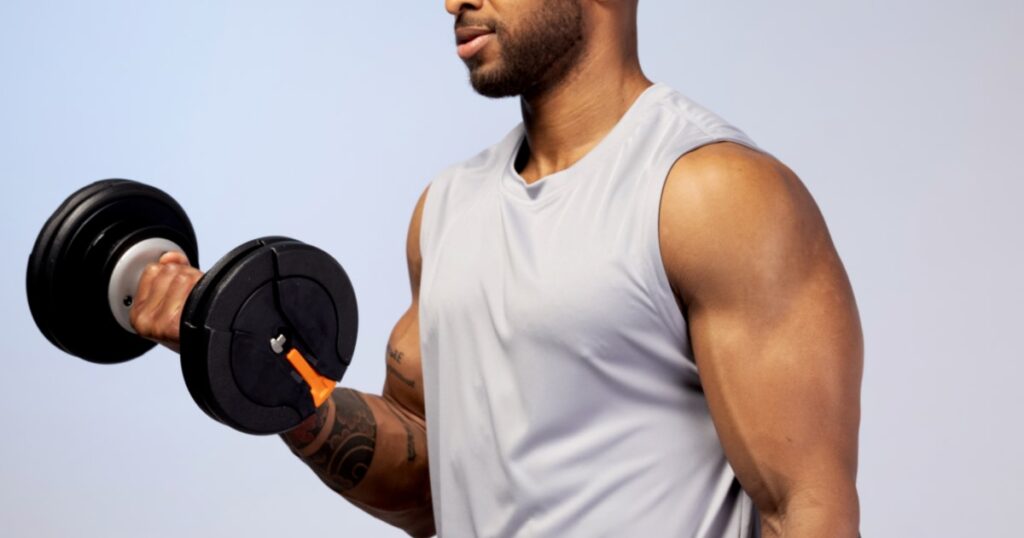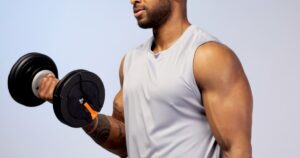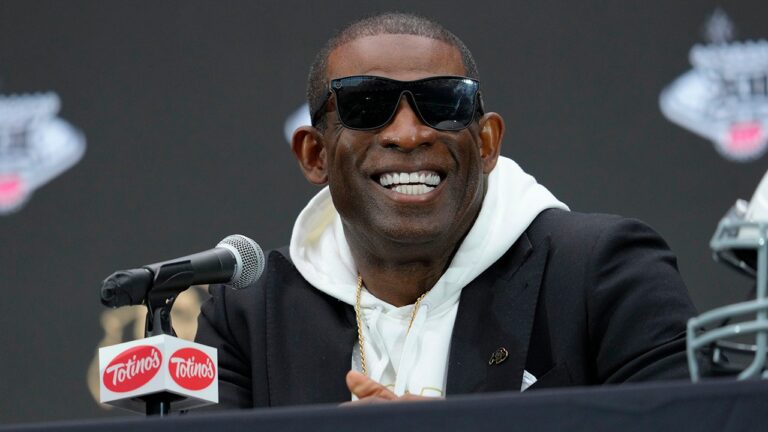Regardless of your age, goals or fitness level, strength training is one of the most beneficial types of exercise you can do. It helps you build and tone muscles, improve bone density, increase mobility and generally feel stronger in your everyday life, says Kollins Ezekh, a certified personal trainer, boxing coach and owner of Members Only Boxing and Fitness in Los Angeles, California. And luckily, you don’t even need to leave your home to get an effective workout in. If you invest in a quality set of dumbbells, learn how to structure a sweat session and get a few basic exercises under your belt, you can create a strength training routine that’s easy to adjust as you advance.
To help you get started, I talked to personal trainers about how to do an at-home dumbbell workout for beginners and what to know before adding strength training to your fitness routine. I also rounded up essential exercise equipment you’ll need and broke down some of the foundational movements experts recommend knowing. A lot of the advice below can be applied in the gym, too.
SKIP AHEAD Step 1: Decide on your workout structure | Step 2: Gather your equipment | Step 3: Do your workout | Why trust NBC Select?
Want more from NBC Select? Sign up for our newsletter, The Selection, and shop smarter.
Step 1: Decide on your workout structure
Before you even pick up dumbbells, think about the structure of your workout. Here’s what experts suggest considering while planning.
How often should you strength train?
The average healthy adult should strength-train twice a week, according to the Centers for Disease Control and Prevention. Experts say that frequency is enough to maintain your current level of strength, but to get stronger and see noticeable results, three times a week is ideal, says Jen Polzak, a certified personal trainer and the director of membership and fitness at Asphalt Green in New York City. Overall, repetition is important: “Our muscles need to be overloaded in a way that stresses them just enough to break down, have time to repair themselves, and adapt to grow stronger muscle tissue,” she says. “Without this adaptation, we won’t get stronger.” Rest days are also important since your muscles need time to recover, so strength training three times a week with one day of rest between sessions is ideal, says McKay Romney, a certified personal trainer and nutritionist based in Salt Lake City, Utah.
That said, “moving a little is better than not moving at all,” says Polzak. “If one day a week is all you can commit to at first, it’s a great place to start and a stepping stone to a better, more consistent program.” Eventually, if you want to increase muscle mass, you can up your strength training frequency to four to six times a week, but you need to do so gradually to avoid injury and burnout, says Romney.
In addition to strength training, make sure you’re doing cardio, which is important for heart health, weight management and lowering your risk of certain diseases, says Ezekh. You can do cardio on the days you don’t strength train, or do back-to-back cardio and strength training sessions on the same day — if you do the latter, Ezekh recommends doing cardio before strength training to warm up your muscles. The average healthy adult needs at least 150 minutes of moderate-intensity aerobic activity a week, like walking, 75 minutes of vigorous-intensity aerobic activity a week, like running or swimming laps, or a combination of the two, according to the CDC.

How long should strength training sessions be?
The sweet spot for a typical strength training session is between 30 and 60 minutes, according to experts. That should involve a warmup, strength training and a cool down (read more about warmups and cool downs below).
Contrary to popular belief, longer strength sessions are not more effective — in fact, you get the most benefits within the first hour or so, says Romney. After that, you may see some benefits, but they’re minimal in comparison. That’s because strength training involves pushing yourself to your maximal or sub-maximum limit, so by extending workouts longer than necessary, you may be negatively impacting your body’s ability to recover, reset and prepare for the next session, says Polzak.
Should you do full-body or split workouts?
Whether you decide to focus on your full-body or a specific area of your body during each strength training session is a matter of personal preference. But for beginners using dumbbells three times a week, Romney recommends doing full-body workouts to make sure you’re exercising all muscle groups. “In general, it’s preferable to stimulate a muscle a couple of times a week to improve strength and growth instead of completely destroying a muscle once a week,” he says.
If you advance to strength training more than three times a week with few rest days, you may want to do split workouts, which involve focusing on different areas of your body each day. For example, you can focus on your upper body twice a week and your lower body twice a week, alternating between the two so your muscles can recover between sessions, says Polzak. At this point, consulting a personal trainer to discuss your goals is also helpful.

Step 2: Make sure you have the right equipment
Once you know your workout structure, gather all the equipment you’ll need to exercise, including supportive clothing and footwear. The products below are from brands that experts or I recommend. I also added a few highly rated items that meet personal trainers’ shopping guidance.
Dumbbells
Experts say dumbbells are one of the best types of weights to keep at home because they’re so versatile. You can do a variety of exercises with them across difficulty levels, and they don’t take up much storage space — Romney recommends getting a rack to keep them organized, or you can stack them up in a closet, store them under a bed or line them up along a wall.
There are two types of dumbbells: fixed, which have one set weight, and adjustable, which let you choose your weight using a rotating dial or removable pin. Romney recommends adjustable dumbbells for at-home workouts. “In the same amount of space as a single set of dumbbells, you get a variety of weights,” he says. However, adjustable dumbbells are usually pricey, so some people prefer to buy a few pairs of lower-priced static dumbbells, especially since you don’t always have to use a heavier set to get stronger, says Polzak: “Before you go heavier in weights, you can do more sets or more repetitions, increase your time under tension with the tempo of an exercise or hold the weight farther away from your midline to recruit even more muscle engagement.” Learn more about how to choose the right weight for your body in the FAQ section below.
Other helpful equipment
Weights are the most important piece of equipment for dumbbell workouts, but a few other accessories can be helpful. For example, adding resistance bands and sliders to exercises can make them more challenging, says Polzak, and using an adjustable bench or an inflatable ball can support your body in certain positions, says Romney. He also recommends covering your floor in a rubber mat while using dumbbells to protect it from potential damage. A yoga mat works well if you already own one, and brands also make specialized rubber flooring if you want to make an area of your home a dedicated gym.
Protective gear
Frequently using dumbbells can cause calluses to form on your palms and the skin around your knuckles to get thicker, says Romney. Wearing weight lifting gloves can help prevent rough skin and make lifting more comfortable. If you advance in your training and start lifting heavier dumbbells, you may also want to invest in a pair of lifting straps, which help you hold onto weights as your forearms start running out of strength, he says.
Clothing and footwear
Your shoes are the most important part of your outfit to think about while using dumbbells. Wear training shoes with a flat base that help you grip the floor, stabilize and equally distribute your weight across both feet, says Ezekh. Never use dumbbells while barefoot or just wearing socks — the last thing you want to do is drop one on uncovered toes.
As for clothing, choose leggings, shorts, shirts or other pieces that are comfortable, easy to move in and not restrictive, says Polzak.
Step 3: Do the workout
Your workout should consist of three parts: a warmup, weightlifting and a cool down. Weightlifting is the main event, while the warmup helps your mind and body prepare for a workout and the cool down begins the recovery phase, says Polzak.
Warmup
The purpose of a warmup is to get your blood pumping so your body is loose and prepared to lift weights, says Ezekh. It’s best to do a dynamic warmup, which engages your muscles through movement, says Romney. For example, you can do exercises like jumping jacks, leg swings and arm circles, or add some cardio by walking or using an elliptical machine, stairmaster or rowing machine. Fleshing out your muscles with a foam roller or massage gun is also helpful.
Weightlifting
There are three ways to organize a weightlifting session, says Polzak. They’re all beneficial, so you can do each one within a week, or choose the style you find most challenging and engaging.
- Supersets: Alternate between doing two different exercises back-to-back with little to no rest in between
- Circuits: Run through a sequence of three or more exercises in a row with minimal rest in between them. Then, repeat the sequence a second and third time.
- Straight sets: Do three sets of an exercise with a short rest period between them before moving onto another exercise.
Regardless of which style workout you do, the American College of Sports Medicine recommends doing two to three sets of eight to 12 repetitions of each exercise. Some exercises are compound movements, which involve multiple muscle groups — squats, deadlifts and overhead presses are a few examples. Others are isolation exercises, which target one muscle group, like bicep curls, tricep kickbacks and hamstring curls, says Romney. Compound movements tend to be more efficient, so he suggests prioritizing them during workouts and saving isolation exercises for the end of a session if you want to focus on one specific area.
To learn a few foundational strength training exercises, experts recommend doing a session or two with a personal trainer, either virtually or in-person, watching videos online or doing programs through fitness apps. I also put together an example of a superset below to help you understand how they come together.
Superset example
This superset consists of two exercises: split squats, a compound movement, and biceps curls, an isolation exercise. You’d do eight to 12 repetitions of each exercise with little to no rest in between, using the appropriate weight for your body. Experts recommend repeating the superset three times with 30 to 90 seconds of rest in between.
Split squats

Begin by kneeling on one knee with both legs bent at 90 degrees. Keep your front foot flat and prop your back foot up on your toes. Either hold one dumbbell with both hands at your chest, or hold one dumbbell in each arm by your sides. Pull your abdomen toward your spine and exhale as you press through your feet to stand up, keeping your feet planted where they are. Inhale as you lower back down to the starting kneeling position. Repeat.
Biceps curls

From a seated or standing position, hold your dumbbells at your sides. Gently squeeze your glutes and pull your abdomen towards your spine. Exhale as you bend your elbows to lift the dumbbells toward your chest, keeping your elbows at your sides. Inhale as you lower the dumbbells to the starting position. Repeat.
Cool down
After using weights, do a static cool down for 5 to 10 minutes, which involves stretching without movement, says Romney. Focus on stretching the parts of your body you targeted with your weight work, like chest and shoulder stretches for the upper body, and hamstring, calf and hip stretches for the lower body. Hold each stretch for about 20 to 30 seconds before moving on to a new one, says Ezekh.
Frequently asked questions
Strength training offers numerous health benefits and is especially important to incorporate into your fitness regime as you age. “As we get older, we start losing muscle mass, so using weights like dumbbells can help us maintain our strength and improve bone density,” says Ezekh. Strength training also helps with mobility and endurance so you can support yourself during daily activities like walking up stairs, lifting heavy grocery bags and picking up kids or pets. It’s also a great way to prevent pain, injury and conditions like arthritis and osteoporosis since increasing your strength protects your joints, bones and muscles, says Romney.
How much weight you should lift depends on whether you have prior experience with dumbbells and your current fitness level, says Polzak. It’s crucial to practice proper form while lifting to do exercises correctly and avoid injury, so you should never feel like you’re straining your body or are unable to maintain good posture. If you do, it’s a sign you’re using too much weight.
Generally, beginners should start with lighter weights between five to 25 pounds, says Romney. You can get a lighter set and a heavier set of static dumbbells, or buy adjustable dumbbells that offer those weights.
To figure out what weight you should lift, Polzak recommends doing the following test:
- Fill up a bag with books, soup cans or other items. Weight it on a scale until it reaches 8 to 15 pounds, and then tie it closed to prevent anything from falling out.
- Do a set of ten squats while holding the weighted bag in front of your chest.
- Evaluate how difficult the set was on a scale from 1 to 10, with 10 being really challenging. If you land between a 6 and 8 on that scale, you likely have the right weight for your lower body exercises. But if you land below a 6, your weights are likely too light, and if you land above a 10, your weights are probably too heavy, she says. You can adjust the weight of the bag until you find the right option for you.
- Repeat this test with an upper body exercise like an overhead press or a row.
Another way to decide if your weights are too light, too heavy or just right is to think about how many repetitions you have left in reserve at the end of a set of 10. “Use a weight where you feel like you could do two more repetitions,” says Romney. “This approach helps you make sure the weight is challenging enough to push your muscles and elicit the desired physical benefits, but isn’t so heavy that you lose your form and increase your chances of injury.” If you feel like you could do more than 10 reps, your weights are likely too light, and if you can’t do more than six reps, your weights are likely too heavy.
The best way to make sure you have good form while lifting weights is to do a session or two with a certified personal trainer. They can watch you do different exercises and correct your form as needed.
If you don’t have access to a personal trainer, either in-person or virtually, Romney recommends doing exercises in front of a full-body mirror or recording yourself. Check your form by comparing it to videos and pictures of professionals demonstrating exercises online — I find YouTube videos and fitness apps very helpful.
Change takes time and consistency, so don’t expect to notice a difference overnight, says Romney. How long it takes to see and feel results differs for everyone — stick with your program and change will come, he says. It’s also important to avoid doing too much at once. “Start with something manageable and build momentum,” says Romney. “The goal is for strength training to become part of your lifestyle, not just a phase you go through, so it’s important that exercise is enjoyable.”
Meet our experts
At NBC Select, we work with experts with specialized knowledge and authority based on relevant training and/or experience. We also ensure that all expert advice and recommendations are made independently and without undisclosed financial conflicts of interest.
- Kollins Ezekh is a certified personal trainer, boxing coach and owner of Members Only Boxing and Fitness in Los Angeles, California.
- Jen Polzak is a certified personal trainer and the director of membership and fitness at Asphalt Green in New York City.
- McKay Romney is a certified personal trainer and nutritionist based in Salt Lake City, Utah.
Why trust NBC Select?
I’m a reporter at NBC Select who has covered health and fitness since 2020, including topics like sports bras, women’s walking shoes, training shoes, wrist weights and exercise mats. To write this article, I interviewed three experts about how to plan a dumbbell workout for beginners, and what equipment you need to do a dumbbell workout at home.
Catch up on NBC Select’s in-depth coverage of tech and tools, wellness and more, and follow us on Facebook, Instagram, Twitter and TikTok to stay up to date.













